engine AUDI A5 COUPE 2011 Owners Manual
[x] Cancel search | Manufacturer: AUDI, Model Year: 2011, Model line: A5 COUPE, Model: AUDI A5 COUPE 2011Pages: 362, PDF Size: 84.88 MB
Page 316 of 362

-L~W~h~a~t~d~o~I~d~o~n~o~w~? :_ _________________________________________ _
What do I do now?
Vehicle tool kit
The too ls are stored underneath the floor panel in the
luggage c ompartment.
Fi g. 2 19 Lu ggag e
c om partm ent : too l k it
When you need access to the vehicle tool kit or jack* , you will need to
t ake out t he spare ti re* and cover~
page 314.
The ve hicle too l kit includes:
• Hook for removing whee l covers *
• Alignmen t pin fo r changing the wheel
• Screwdriver wi th reversib le blade
• Tool for changing light bulbs
• Revers ib le b it (reve rs ible To rx bit for chang ing lig ht bulbs)
• Rod for jack
• Jack*
• Lu g wre nc h
• Towing eye
Some of the veh icle items listed above a re p rovided o n cert ain mo dels
only or are opt ional extras.
Before ret urning the jack* to its place, retract the jack arm fully.
& WARNING
• Never u se the screw dri ver he x head to tighten wheel bolts,
s in ce the bolts cannot attain th e neces sa ry tightening torque if
you use the he x head , potent ially caus ing an accident.
• The fa ctory-supplied jack i s intended only for your vehicle
model. Unde r no circumstances should it be used to lift heavy
vehicles or other loads ; you risk injuring you rself .
• Never start the engine whe n the vehicle is raised , which could
caus e an acci dent .
• Support the vehicle securely with appropriate stands if work is
to be performed underneath the vehicle; otherwise , there is a
potential risk for injury. •
App lies to vehicles : w ith space -saving spa re t ire
Space-saving spare tire (compact
spare tire)*
The spare tire/wheel is located in the lugg age comport
ment under the cargo floor cover . It is intended for short
te rm use only.
Fi g. 2 20 S pare t ir e _.,,
Page 318 of 362
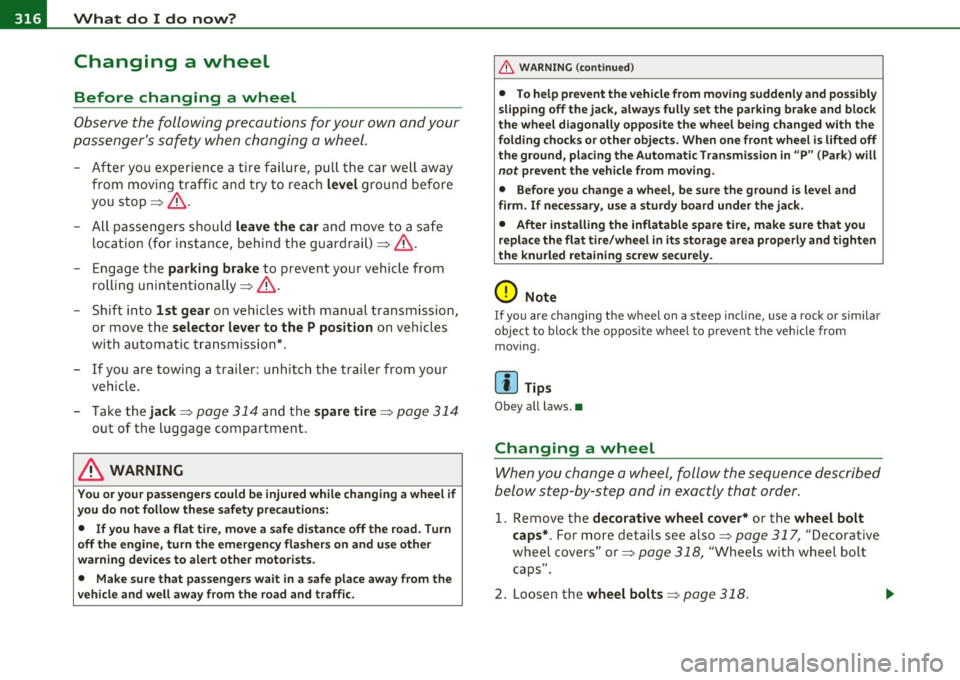
lffll.___W __ h_a_ t_ d_ o_ I_ d_o_ n_ o_w _ ? _____________________________________________ _
Changing a wheel
Before changing a wheel
Observe the following precautions for your own and your
passenger's safety when changing a wheel.
- After you experience a tire failure, pull the car well away
from moving traffic and try to reach
level ground before
you stop
~ & .
- All passengers should
leave the car and move to a safe
location (for instance, behind the guardrail)~& .
- Engage the
parking brake to prevent your vehicle from
rolling unintentionally~ &.
- Shift into
1st gear on vehicles with manual transmission,
or move the
selector lever to the P position on vehicles
with automatic transmission*.
- If you are towing a trailer: unhitch the trailer from your vehicle.
- Take the
jack~ page 314 and the spare tire~ page 314
out of the luggage compartment.
& WARNING
You or your passengers could be injured while changing a wheel if
you do not follow these safety precautions:
• If you have a flat tire, move a safe distance off the road. Turn
off the engine, turn the emergency flashers on and use other
warning devices to alert other motorists.
• Make sure that passengers wait in a safe place away from the
vehicle and well away from the road and traffic.
& WARNING (continued)
• To help prevent the vehicle from moving suddenly and possibly
slipping off the jack, always fully set the parking brake and block
the wheel diagonally opposite the wheel being changed with the
folding chocks or other objects. When one front wheel is lifted off
the ground, placing the Automatic Transmission in "P" (Park) will
not prevent the vehicle from moving.
• Before you change a wheel, be sure the ground is level and
firm. If necessary, use a sturdy board under the jack.
• After installing the inflatable spare tire, make sure that you
replace the flat tire/wheel in its storage area properly and tighten
the knurled retaining screw securely.
0 Note
If you are changing the wheel on a steep incline, use a rock or simila r
object to block the opposite wheel to prevent the vehicle from
moving.
[ i] Tips
Obey all laws. •
Changing a wheel
When you change a wheel, follow the sequence described
below step-by-step and in exactly that order.
1. Remove the decorative wheel cover* or the wheel bolt
caps* .
For more details see also~ page 317, "Decorative
wheel covers" or~
page 318, "Wheels with wheel bolt
caps".
2. Loosen the
wheel bolts~ page 318. .,_
Page 326 of 362

-Fuses and bulbs
~-;,_;__:_:_;..:..:.:....::~=---------------------------
Left cockpit fuse assignment
No. C onsumer
Fu se p anel@ (bla ck )
1 Dynamic steering
3 Homelink
5 Climate control
6 Right headlight range adjustment
7 Left headlight range adjustment
F ig. 229 Left cockpit:
f use panel w ith p lastic
clip
Amps
5
5
5
8 Vehicle electrical system control module 1
5
5
5
5 9 Adaptive Cruise Control No. Con
sumer Amps
10 Shift gate 5
11 Heater washer fluid nozzles 5
12 Climate control 5
13 Cell phone prep 5
14 A irbag 5
15 Terminal 15 25
16 Terminal 15 engine
40
Fuse panel ® (brow n)
1 Automatic dimming interior rearv
iew mirror
5
2 Clutch sensor 5
3 Gasoline fuel pump
25
5 Left
seat heating with/without seat heating
15/30
6 Elect ronic Stabilization Program 10
7 Horn
25
8 Left door w
indow regulator motor
30
9 Wiper motor 30
10 Electronic Stabilization Program 25
11 Left doors 15
12 Ra in and light sensor 5
Fuse p an el © (red )
3 Lumbar support 10
4 Dynamic steering 35
5 Antenna (Avant)
5
6 Vehicle electrical system control module 1 35
7 Vehicle electrical system control modu le 1 20
Page 329 of 362
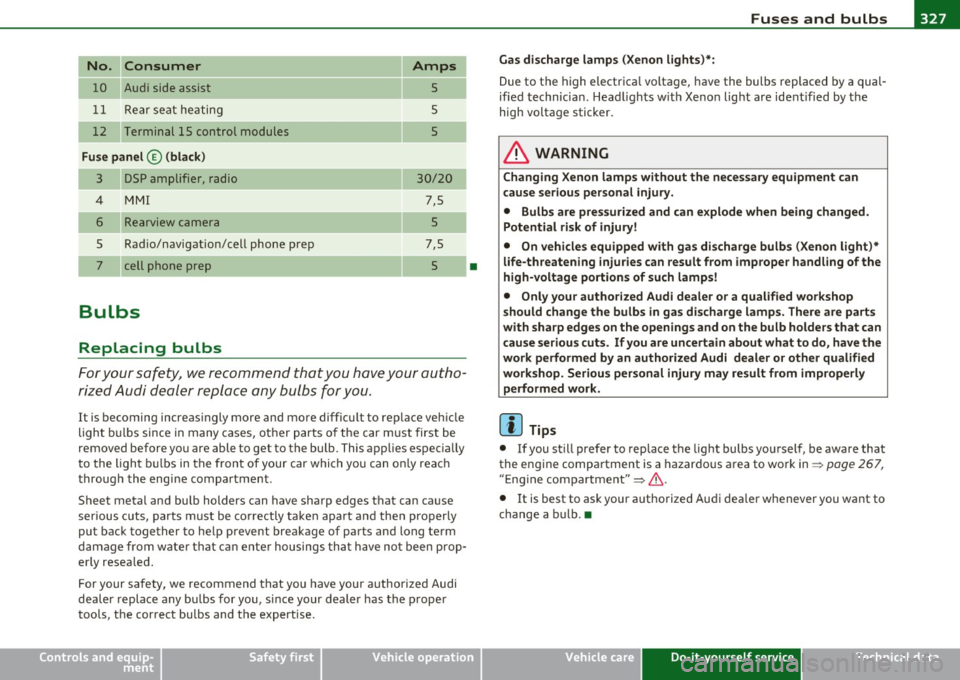
_______________________________________________ F_u _s_ e_ s_ a_ n_ d_ b_u _ l_ b _ s __ lR
No. I I Consumer
1 0 A udi side assis t
1 1 Rea r seat he ating
1 2 T ermin al 15 control mod ules
Fuse panel © (black)
3 D 5P amplifi er, rad io
4 MMI
5
Rea rvi ew c amer a
Rad io/nav igatio n/cell phon e prep
cell phone prep
Bulbs
Replacing bulbs
Amps
5
5
5
30/ 20
7,5
5
7,5
5 •
For your sa fety, we recommend tha t you have your autho
ri zed A udi de aler repl ace any bulbs for y ou.
It is becoming increas ingly more and more difficu lt to replace veh icle
ligh t bulbs since in many cases, other parts o f the car m ust first be
removed before you are able to get to the bu lb. This app lies espec ia lly
t o the ligh t bulbs in the fron t of your car which you can on ly reac h
t hroug h the engi ne compartment .
Sheet meta l and bu lb holders can have sharp edges that can ca use
serious cuts, parts must be co rrectly take n apart a nd the n properly
put back together to he lp prevent breakage of parts and long term
damage from w ate r that c an ente r housings tha t have no t been prop
er ly resea led.
F or your safety, we recommend that you have your authorized Audi
dealer replace any bu lbs for you, s ince your dealer has the p rope r
too ls, the cor rect bu lbs and the expertise.
Safety first Gas discharge lamps
(Xenon lights}*:
Due to the high electr ica l voltage, have the bulbs replaced by a qual
ified technicia n. Headl ights w it h Xe non lig ht are ident ified by t he
high voltage sticker.
& WARNING
Changing Xenon lamp s without the nece ssary equipment can
cause serious personal injury.
• Bulbs are pre ssurized and can explode when being changed.
Potential risk of injury!
• On vehicle s equipp ed with ga s discharge bulbs (Xenon light)*
life-threatening injuries can result from improper handling of the
high-voltage portions of such lamps!
• Only your authorized Audi dealer or a qualified workshop
s hould change the bulbs in gas discharge lamp s. There are parts
with sharp edges on the openings and on the bulb holders that can
c au se seriou s cuts. If you are uncertain about what to do , have the
work performed by an authoriz ed Audi dealer or other qualified
workshop. Seriou s person al injury may result from improperly
performed work.
(I] Tips
• If you st ill prefer to replace t he lig ht bulbs yourself, be aware that
the engine compartment is a hazardo us a rea to work in:::)
page 267 ,
" E ng ine compartme nt" :::) & .
• It is best to ask your a uthorized Au di dea ler w henever you wa nt to
change a b ulb. •
Vehicle care Do-it-yourself service Technical data
Page 330 of 362
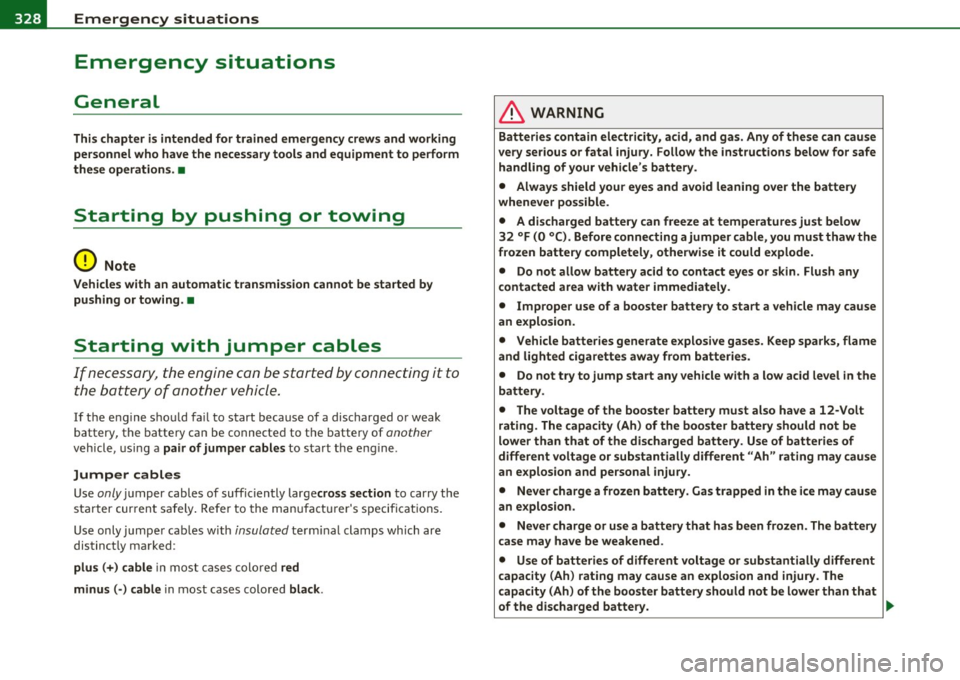
lffll.___E_ m_ e_ r-' g=- e_n_ c=-y _ s_it _ u _ a_t_ i_ o _ n_ s ______________________________________________ _
Emergency situations
General
This chapter is intended for trained emergency crew s and working
pe rsonnel who have the necessary tool s and equipment to perform
the se operation s. •
Starting by pushing or towing
0 Note
Veh icles with an automatic transmission cannot be started by
pushing or towing .•
Starting with jumper cables
If necess ary, the engine can be started b y connectin g it to
t he bat tery of another vehicle.
If the e ng ine shou ld fa il to start because of a discharged or weak
battery, the batte ry can be connected to t he battery of
another
veh icle, us ing a pair of jump er cables to start t he eng ine .
Jumper cables
Use only jumper cables of suffic iently large cross section to carry the
sta rter cur rent s afely . Refer to the m an ufa ct ur er's specificat ions.
Use only j umpe r cab les with
insulated te rmi nal clamps wh ich are
distinct ly marked :
plu s(+) cable i n most cases colored red
minus (-) cable i n most cases colored black .
& WARNING
Batterie s contain el ectricity, acid, and gas . Any of the se can cause
very serious or fatal injury. Follow the inst ructions below for safe
handling of your vehicle 's battery.
• Always shield your eyes and avoid leaning over the battery
whenev er po ssible .
• A discharged battery can freeze at temperatures just below
32 °F (0 °C ). Before connecting a jumper cable, you must thaw the
frozen battery completely, otherwise it could explode.
• Do not allow battery acid to contact eyes or sk in . Flush any
contacted area with water immedi ately .
• Improper use of a booste r battery to start a vehicle may cause
an explosion .
• Vehicle batteries generate e xplosive gases. Keep sparks, flame
and lighted cigarettes away from batterie s.
• Do not try to jump start any vehicle with a low acid level in the
battery.
• The voltage of the booster battery must also have a 12-Volt
rating. The capacity (Ah) of the booster battery should not be
lower than that of the discharged battery . Use of batteries of
different voltage or substantially different "Ah " rating may cau se
an e xplosion and personal injury.
• Never charge a frozen battery . Gas trapped in the ice may cause
an explosion.
• Never charge or use a battery that has been frozen. The battery
case may have be weakened .
• Use of batteries of different voltage or substantially different
capacity (Ah) rating may cause an explosion and injury . The
capacity (Ah) of the booster battery should not be lower than that
of the discharged battery. .,_
Page 331 of 362
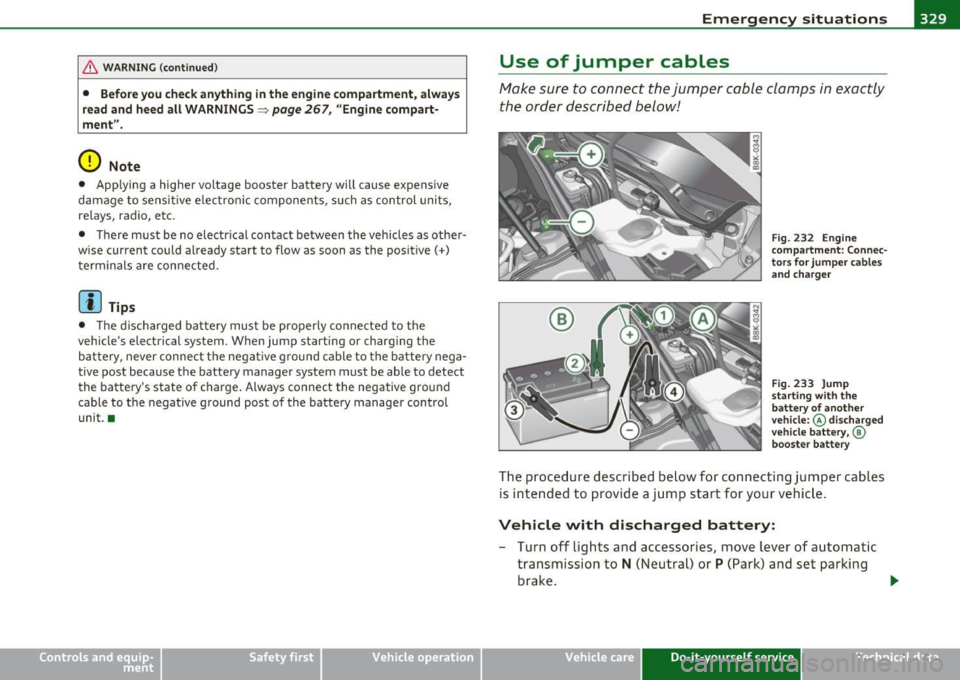
_____________________________________________ E_ m___;, e_r-=g ~ e_ n_c,_:!y:.__: s_i:..:t ..:..u :..:a;;,. t.:.; i...: o :..: n...:..:. s _ __,J_
& WA RNING (co ntinued )
• Before you che ck anything in the engine compartment , always
read and heed all WARNINGS~
page 267, "Engine compart
ment ".
0 Note
• App lying a higher vo ltage booster battery will cause expensive
damage to sens itive e lec tron ic components, such as contro l units,
re lays, rad io, etc.
• Th ere must be no electrical contac t between the vehicles as othe r
wise current could a lready start to flow as soon as the posit ive(+)
t erm inals are con nected.
[I] Tips
• Th e discharged ba tte ry mus t be properly co nnecte d to the
vehicle's electrical system . When jump starting or charging the
bat tery, never connec t the negat ive ground cable to the batte ry nega
tive post because the battery manager system must be able to detect
t he battery's state of charge . Always connect the negative ground
cable to the negative ground post of the battery manage r contro l
unit. •
Vehicle OP-eration
Use of jumper cables
Make sure to conne ct the jumper c able clamps in e xactly
the order described bel ow!
Fig. 232 Engine
c omp artment : C on nec
t o rs for jum per cable s
a nd ch arger
Fi g. 233 J ump
st arti ng with th e
battery of anot her
ve hicl e:@ disc harged
v ehi cle batt ery ,©
bo oste r batte ry
T he p roced ure descr ib ed below for co nnecting jumper cables
is intended to provide a j ump start for yo ur veh icle.
Vehicle with discharged battery:
- Turn o ff ligh ts an d accessories, move lever o f au tomatic
t ra nsmission to
N (Ne utral) o r P (P ark) and s et parking
brake .
~
Vehicle care Do-it-yourself service iTechnical data
Page 332 of 362
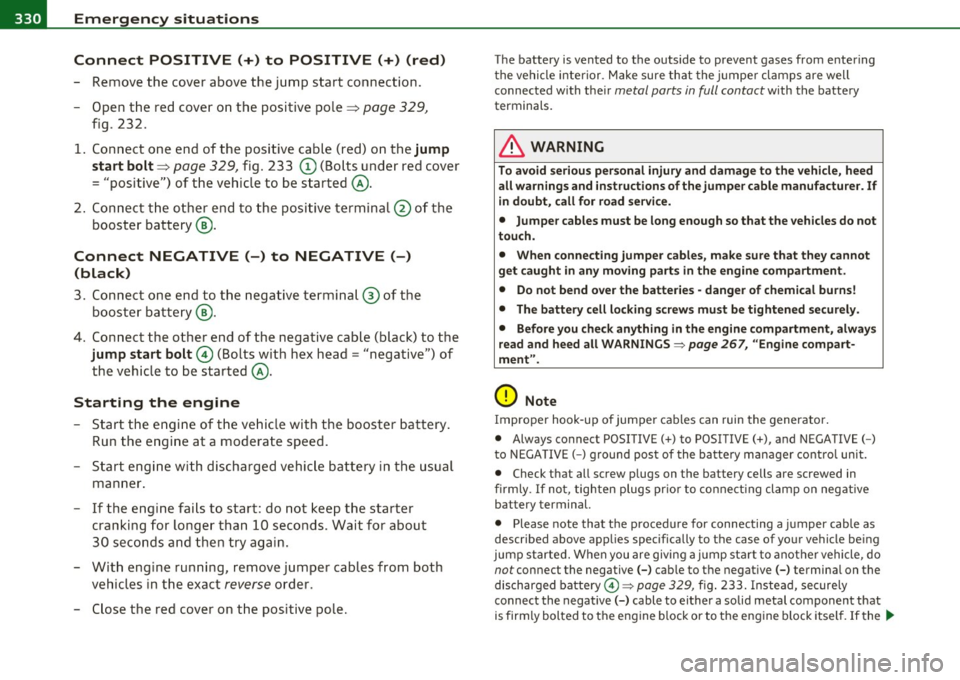
lffl!I.___E_ m_ e_r -=g =- e_ n_c -=y ;..._ s_i_t _u _a _ t_ i_ o _ n_ s ____________________________________________ _
Connect POSITIVE(+) to POSITIVE(+) (red)
- Remove the cover above the jump start connection .
- Open t he red cover on the positive pole~
page 329,
fig. 232.
1. Connect one end of the positive cable (red) on the
jump
start bolt~
page 329, fig. 233 (D (Bolts under red cover
= "positive") of the vehicle to be started @.
2. Connect the other end to the positive terminal @of the
booster battery ®·
Connect NEGATIVE(-) to NEGATIVE(-)
(black)
3. Connect one end to the negative terminal ® of the
booster battery @.
4. Connect the other end of the negative cable (black) to the
jump start bolt© (Bolts with hex head = "negative") of
the vehicle to be started @.
Starting the engine
- Start the engine of the vehicle with the booster battery.
Run the engine at a moderate speed.
- Start engine with discharged vehicle battery in the usual
manner.
- If the engine fails to start: do not keep the starter cranking for longer than 10 seconds. Wait for about
30 seconds and then try again.
- With engine running, remove jumper cables from both
vehicles in the exact
reverse order .
- Close the red cover on the positive pole.
The battery is vented to the outside to prevent gases from entering
the vehicle interior . Make sure that the jumper clamps are well
connected with their
metal parts in full contact with the battery
terminals.
& WARNING
To avoid serious personal injury and damage to the vehicle, heed
all warnings and instructions of the jumper cable manufacturer. If
in doubt, call for road service.
• Jumper cables must be long enough so that the vehicles do not
touch.
• When connecting jumper cables, make sure that they cannot
get caught in any moving parts in the engine compartment.
• Do not bend over the batteries· danger of chemical burns!
• The battery cell locking screws must be tightened securely.
• Before you check anything in the engine compartment, always
read and heed all WARNINGS~
page 267, ''Engine compart
ment".
0 Note
Improper hook-up of jumper cables can ruin the generator.
• Always connect POSITIVE(+) to POSITIVE(+), and NEGATIVE( -)
to NEGATIVE(-) ground post of the battery manager control unit.
• Check that all screw plugs on the battery cells are screwed in
firmly . If not, tighten plugs prior to connecting clamp on negative
battery terminal.
• Please note that the procedure for connecting a jumper cable as
described
above app lies specifically to the case of your vehicle be ing
jump started. When you are giving a jump start to another vehicle, do
not connect the negative (-) cab le to the negative(-) terminal on the
discharged battery©~
page 329, fig. 233. Instead, securely
connect the negative(-) cable to either a solid metal component that
is firmly bolted to the engine block or to the engine block itself.
If the _,,,
Page 333 of 362
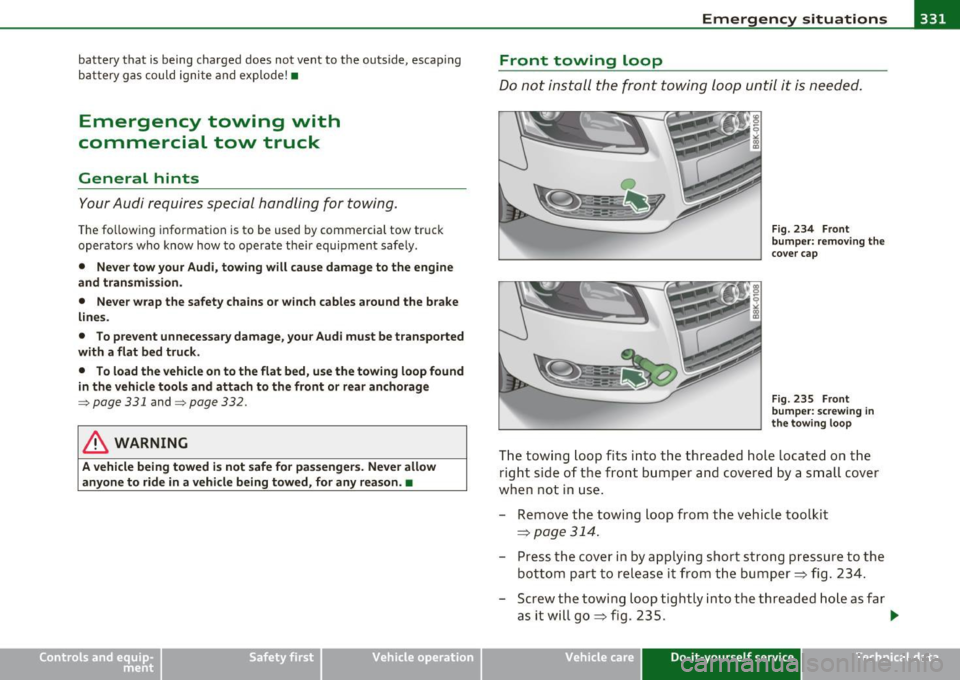
Emergency situations Ill -------------=---:.-----J
battery that is being charged does not vent to the outside, escaping
battery gas could ignite and explode!•
Emergency towing with
commercial tow truck
General hints
Your Audi requires special handling for towing.
The following information is to be used by commercial tow truck
operators who know how to operate their equipment safely .
• Never tow your Audi, towing will cause damage to the engine
and transmission.
• Never wrap the safety chains or winch cables around the brake
lines.
• To prevent unnecessary damage, your Audi must be transported
with a flat bed truck.
• To load the vehicle on to the flat bed, use the towing loop found
in the vehicle tools and attach to the front or rear anchorage
~ page 331 and ~ page 332.
& WARNING
A vehicle being towed is not safe for passengers. Never allow
anyone to ride in a vehicle being towed, for any reason. •
Vehicle OP-eration
Front towing Loop
Do not install the front towing loop until it is needed.
Fig. 234 Front
bumper: removing the
cover cap
Fig. 235 Front
bumper: screwing in
the towing loop
The towing loop fits into the threaded hole located on the
right side of the front bumper and covered by a small cover
when not in use.
- Remove the towing loop from the vehicle toolkit
=> page 314.
- Press the cover in by applying short strong pressure to the
bottom part to release it from the bumper=> fig. 234.
- Screw the towing loop tightly into the threaded hole as far
asitwillgo=,,fig.235.
~
Vehicle care Do-it-yourself service iTechnical data
Page 336 of 362

lffll.___E_ m_ e_ r-' g=- e_n_ c=-y _ s_it _ u _ a_t_ i_ o _ n_ s ______________________________________________ _
in. WARNING
• To reduce the risk of serious injury and vehicle damage.
-Always lift the vehicle only at the special workshop hoist and
floor jack lift points illustrated
=> page 333, fig. 238 and
=> page 333, fig. 239.
- Failure to lift the vehicle at these points could cause the
vehicle to tilt or fall from a lift if there is a change in vehicle
weight distribution and balance. This might happen, for
example, when heavy components such as the engine block or
transmission are removed.
• When removing heavy components like these, anchor vehicle
to hoist or add corresponding weights to maintain the center of
gravity. Otherwise, the vehicle might tilt or slip off the hoist,
causing serious personal injury.
0 Note
• Be aware of the following points before lifting the vehicle :
-The vehicle should never be lifted or jacked up from under
neath the engine oil pan, the transmission housing, the front or
rear axle or the body side members. This could lead to serious
damage.
- To avoid damage to the underbody or chassis frame, a rubber
pad must be inserted between the floor jack and the lift points.
- Before driving over a workshop hoist, check that the vehicle
weight does not exceed the permissible lifting capacity of the hoist.
- Before driving over a workshop hoist, ensure that there is sufficient clearance between the hoist and low parts of the
vehicle. •
Page 338 of 362

___ G_ e_n_ e_r _a _ l_ in_ f_o _r_ m_ a_ t_io _ n _______________________________________________ _
General information
Explanation of technical data
Some of the technical data listed in this manual requires
further explanation.
The technical data for your vehicle is listed in the charts starting on
~ page 339 . This sect ion prov ides genera l information, notes and
restrictions which app ly to this data .•
Veh icle identification
The key data is given on the vehicle identification number
(VIN) plate and the vehicle data sticker.
F ig. 2 40 V ehicle I den
t ifi ca tion Nu mbe r
(V IN ) plate: locat io n
o n d river's s id e d ash
p an el Fi
g. 2 41 Th e vehicle
i d enti ficati on l abel -
in side the l ugga ge
co mpa rtme nt
The Vehicle Id ent ifi cat ion Number (VlN )
is located on the driver's s ide so that it is visible from the outside
through the windshield ~ fig . 240 . You can also d isp lay the Vehicle
Identification Number of your vehicle in the radio or in the MMI*.
Select :
I CARI function button> Veh icle ID numb er (VIN ).
The vehicle identifica tion lab el
is located in the luggage compartment near the battery .
The label~ fig . 241 shows the following vehicle data:
© Production control No.
@ Vehicle identification No.
® Type code n umber
@ Type designat io n/eng ine output in Kilow atts
© Engine and transmission code letter
© Paint No./Interior
(j) Optional equipment No.'s
Vehicle data 2 to 7 are also found in your Warranty
& Maintenance
booklet . .,,